Copyright © 2004 South-Western 2626 Saving, Investment,





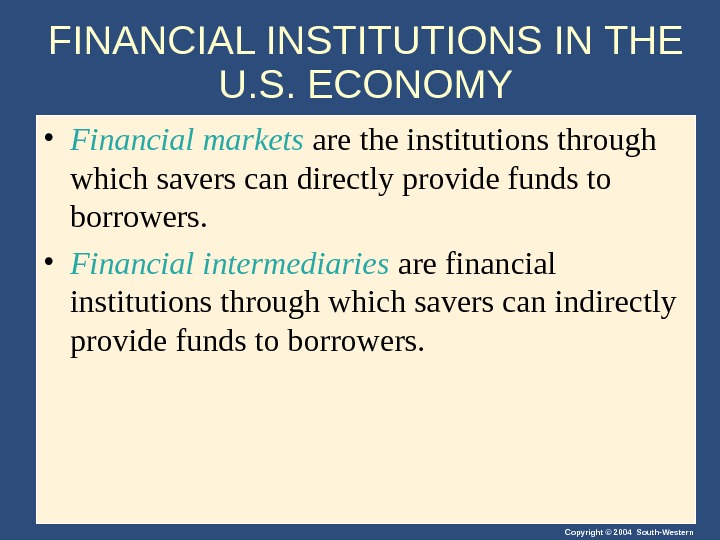

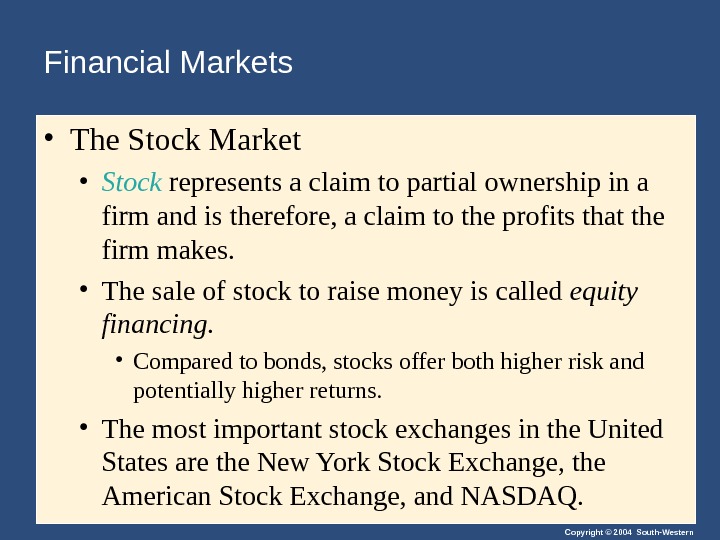
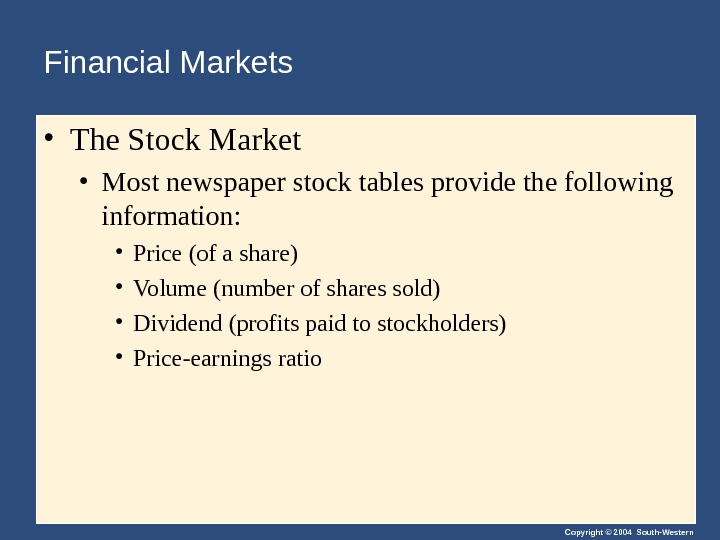
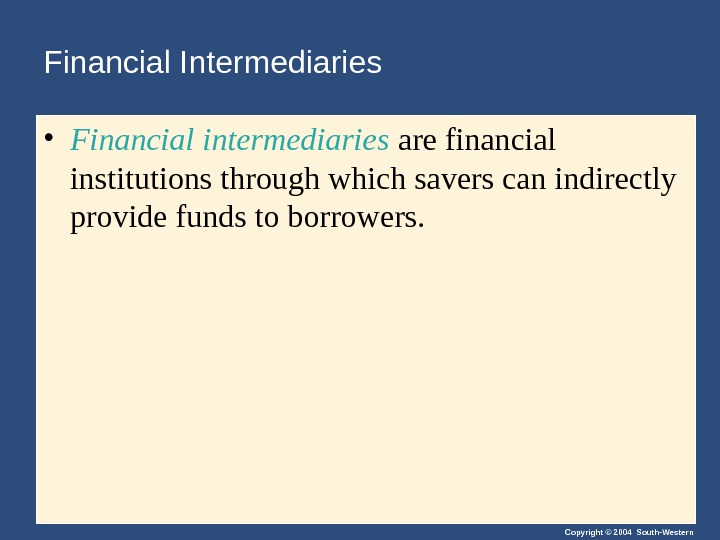


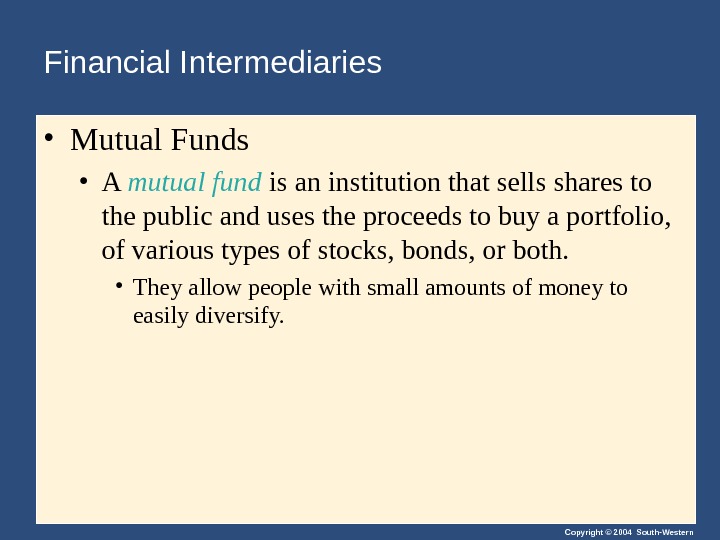


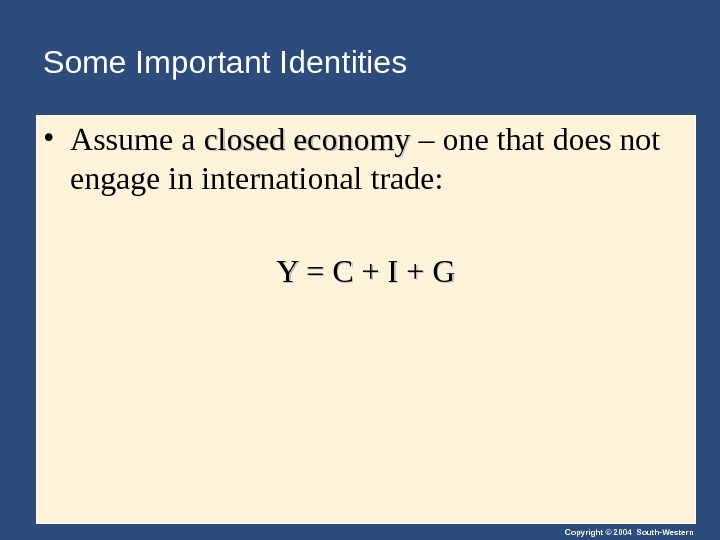
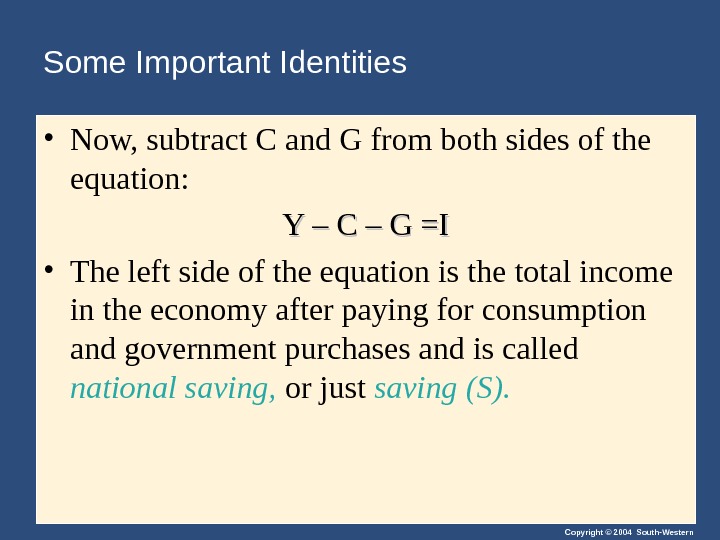



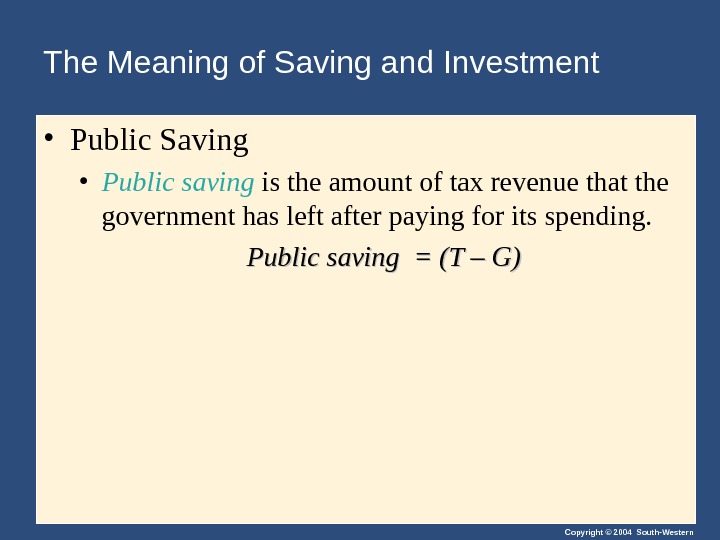


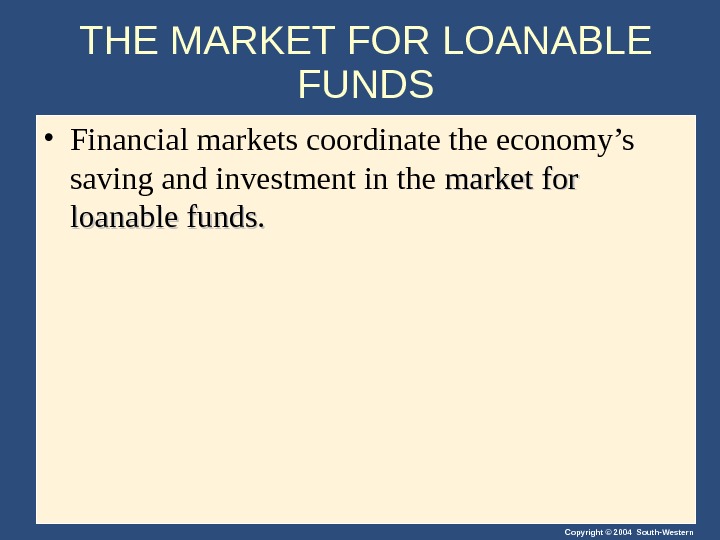

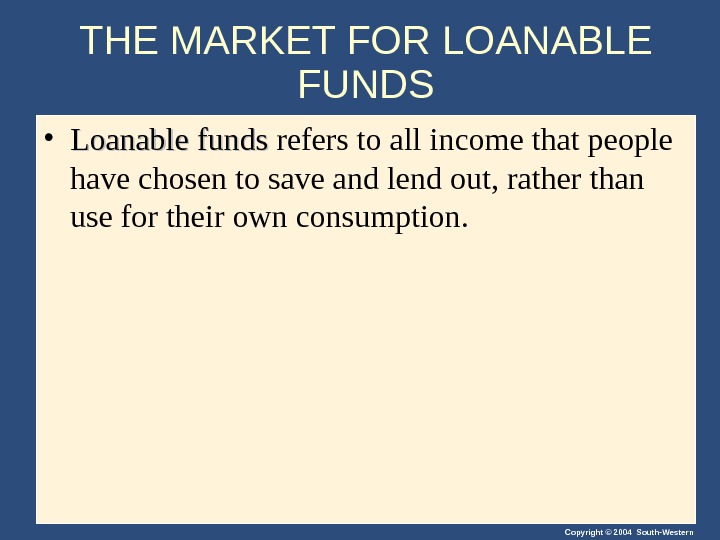







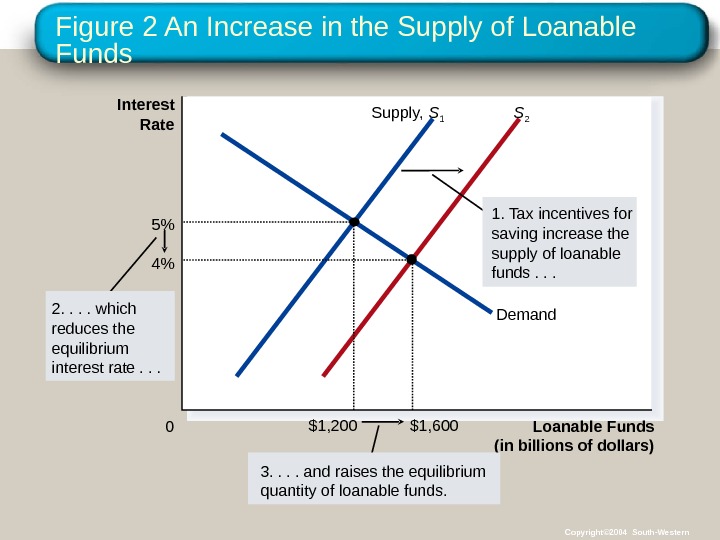















26_saving_investment.ppt
- Размер: 1.1 Mегабайта
- Количество слайдов: 48
Описание презентации Copyright © 2004 South-Western 2626 Saving, Investment, по слайдам
 Copyright © 2004 South-Western 2626 Saving, Investment, and the Financial System
Copyright © 2004 South-Western 2626 Saving, Investment, and the Financial System
 Copyright © 2004 South-Western. The Financial System • The financial system consists of the group of institutions in the economy that help to match one person’s saving with another person’s investment. • It moves the economy’s scarce resources from savers to borrowers.
Copyright © 2004 South-Western. The Financial System • The financial system consists of the group of institutions in the economy that help to match one person’s saving with another person’s investment. • It moves the economy’s scarce resources from savers to borrowers.
 Copyright © 2004 South-Western. FINANCIAL INSTITUTIONS IN THE U. S. ECONOMY • The financial system is made up of financial institutions that coordinate the actions of savers and borrowers. • Financial institutions can be grouped into two different categories: financial markets and financial intermediaries.
Copyright © 2004 South-Western. FINANCIAL INSTITUTIONS IN THE U. S. ECONOMY • The financial system is made up of financial institutions that coordinate the actions of savers and borrowers. • Financial institutions can be grouped into two different categories: financial markets and financial intermediaries.
 Copyright © 2004 South-Western. FINANCIAL INSTITUTIONS IN THE U. S. ECONOMY • Financial Markets • Stock Market • Bond Market • Financial Intermediaries • Banks • Mutual Funds
Copyright © 2004 South-Western. FINANCIAL INSTITUTIONS IN THE U. S. ECONOMY • Financial Markets • Stock Market • Bond Market • Financial Intermediaries • Banks • Mutual Funds
 Copyright © 2004 South-Western. FINANCIAL INSTITUTIONS IN THE U. S. ECONOMY • Financial markets are the institutions through which savers can directly provide funds to borrowers. • Financial intermediaries are financial institutions through which savers can indirectly provide funds to borrowers.
Copyright © 2004 South-Western. FINANCIAL INSTITUTIONS IN THE U. S. ECONOMY • Financial markets are the institutions through which savers can directly provide funds to borrowers. • Financial intermediaries are financial institutions through which savers can indirectly provide funds to borrowers.
 Copyright © 2004 South-Western. Financial Markets • The Bond Market • A bond is a certificate of indebtedness that specifies obligations of the borrower to the holder of the bond. • Characteristics of a Bond • Term : The length of time until the bond matures. • Credit Risk : The probability that the borrower will fail to pay some of the interest or principal. • Tax Treatment : The way in which the tax laws treat the interest on the bond. • Municipal bonds are federal tax exempt. IOU
Copyright © 2004 South-Western. Financial Markets • The Bond Market • A bond is a certificate of indebtedness that specifies obligations of the borrower to the holder of the bond. • Characteristics of a Bond • Term : The length of time until the bond matures. • Credit Risk : The probability that the borrower will fail to pay some of the interest or principal. • Tax Treatment : The way in which the tax laws treat the interest on the bond. • Municipal bonds are federal tax exempt. IOU
 Copyright © 2004 South-Western. Financial Markets • The Stock Market • Stock represents a claim to partial ownership in a firm and is therefore, a claim to the profits that the firm makes. • The sale of stock to raise money is called equity financing. • Compared to bonds, stocks offer both higher risk and potentially higher returns. • The most important stock exchanges in the United States are the New York Stock Exchange, the American Stock Exchange, and NASDAQ.
Copyright © 2004 South-Western. Financial Markets • The Stock Market • Stock represents a claim to partial ownership in a firm and is therefore, a claim to the profits that the firm makes. • The sale of stock to raise money is called equity financing. • Compared to bonds, stocks offer both higher risk and potentially higher returns. • The most important stock exchanges in the United States are the New York Stock Exchange, the American Stock Exchange, and NASDAQ.
 Copyright © 2004 South-Western. Financial Markets • The Stock Market • Most newspaper stock tables provide the following information: • Price (of a share) • Volume (number of shares sold) • Dividend (profits paid to stockholders) • Price-earnings ratio
Copyright © 2004 South-Western. Financial Markets • The Stock Market • Most newspaper stock tables provide the following information: • Price (of a share) • Volume (number of shares sold) • Dividend (profits paid to stockholders) • Price-earnings ratio
 Copyright © 2004 South-Western. Financial Intermediaries • Financial intermediaries are financial institutions through which savers can indirectly provide funds to borrowers.
Copyright © 2004 South-Western. Financial Intermediaries • Financial intermediaries are financial institutions through which savers can indirectly provide funds to borrowers.
 Copyright © 2004 South-Western. Financial Intermediaries • Banks • take deposits from people who want to save and use the deposits to make loans to people who want to borrow. • pay depositors interest on their deposits and charge borrowers slightly higher interest on their loans.
Copyright © 2004 South-Western. Financial Intermediaries • Banks • take deposits from people who want to save and use the deposits to make loans to people who want to borrow. • pay depositors interest on their deposits and charge borrowers slightly higher interest on their loans.
 Copyright © 2004 South-Western. Financial Intermediaries • Banks help create a medium of exchange by allowing people to write checks against their deposits. • A medium of exchanges is an item that people can easily use to engage in transactions. • This facilitates the purchases of goods and services.
Copyright © 2004 South-Western. Financial Intermediaries • Banks help create a medium of exchange by allowing people to write checks against their deposits. • A medium of exchanges is an item that people can easily use to engage in transactions. • This facilitates the purchases of goods and services.
 Copyright © 2004 South-Western. Financial Intermediaries • Mutual Funds • A mutual fund is an institution that sells shares to the public and uses the proceeds to buy a portfolio, of various types of stocks, bonds, or both. • They allow people with small amounts of money to easily diversify.
Copyright © 2004 South-Western. Financial Intermediaries • Mutual Funds • A mutual fund is an institution that sells shares to the public and uses the proceeds to buy a portfolio, of various types of stocks, bonds, or both. • They allow people with small amounts of money to easily diversify.
 Copyright © 2004 South-Western. Financial Intermediaries • Other Financial Institutions • Credit unions • Pension funds • Insurance companies • Loan sharks
Copyright © 2004 South-Western. Financial Intermediaries • Other Financial Institutions • Credit unions • Pension funds • Insurance companies • Loan sharks
 Copyright © 2004 South-Western. SAVING AND INVESTMENT IN THE NATIONAL INCOME ACCOUNTS • Recall that GDP is both total income in an economy and total expenditure on the economy’s output of goods and services: Y = C + I + G + NX
Copyright © 2004 South-Western. SAVING AND INVESTMENT IN THE NATIONAL INCOME ACCOUNTS • Recall that GDP is both total income in an economy and total expenditure on the economy’s output of goods and services: Y = C + I + G + NX
 Copyright © 2004 South-Western. Some Important Identities • Assume a closed economy – one that does not engage in international trade: Y = C + I + G
Copyright © 2004 South-Western. Some Important Identities • Assume a closed economy – one that does not engage in international trade: Y = C + I + G
 Copyright © 2004 South-Western. Some Important Identities • Now, subtract C and G from both sides of the equation: Y – C – G =I • The left side of the equation is the total income in the economy after paying for consumption and government purchases and is called national saving, or just saving (S).
Copyright © 2004 South-Western. Some Important Identities • Now, subtract C and G from both sides of the equation: Y – C – G =I • The left side of the equation is the total income in the economy after paying for consumption and government purchases and is called national saving, or just saving (S).
 Copyright © 2004 South-Western. Some Important Identities • Substituting S for Y — C — G , the equation can be written as: S = I
Copyright © 2004 South-Western. Some Important Identities • Substituting S for Y — C — G , the equation can be written as: S = I
 Copyright © 2004 South-Western. Some Important Identities • National saving, or saving, is equal to: S = I S = Y – C – G S = (Y – T – C) + (T – G)
Copyright © 2004 South-Western. Some Important Identities • National saving, or saving, is equal to: S = I S = Y – C – G S = (Y – T – C) + (T – G)
 Copyright © 2004 South-Western. The Meaning of Saving and Investment • National Saving • National saving is the total income in the economy that remains after paying for consumption and government purchases. • Private Saving • Private saving is the amount of income that households have left after paying their taxes and paying for their consumption. Private saving = (Y – T – C)
Copyright © 2004 South-Western. The Meaning of Saving and Investment • National Saving • National saving is the total income in the economy that remains after paying for consumption and government purchases. • Private Saving • Private saving is the amount of income that households have left after paying their taxes and paying for their consumption. Private saving = (Y – T – C)
 Copyright © 2004 South-Western. The Meaning of Saving and Investment • Public Saving • Public saving is the amount of tax revenue that the government has left after paying for its spending. Public saving = (T – G)
Copyright © 2004 South-Western. The Meaning of Saving and Investment • Public Saving • Public saving is the amount of tax revenue that the government has left after paying for its spending. Public saving = (T – G)
 Copyright © 2004 South-Western. The Meaning of Saving and Investment • Surplus and Deficit • If T > G , the government runs a budget surplus because it receives more money than it spends. • The surplus of T — G represents public saving. • If G > T , the government runs a budget deficit because it spends more money than it receives in tax revenue.
Copyright © 2004 South-Western. The Meaning of Saving and Investment • Surplus and Deficit • If T > G , the government runs a budget surplus because it receives more money than it spends. • The surplus of T — G represents public saving. • If G > T , the government runs a budget deficit because it spends more money than it receives in tax revenue.
 Copyright © 2004 South-Western. The Meaning of Saving and Investment • For the economy as a whole, saving must be equal to investment. S = I
Copyright © 2004 South-Western. The Meaning of Saving and Investment • For the economy as a whole, saving must be equal to investment. S = I
 Copyright © 2004 South-Western. THE MARKET FOR LOANABLE FUNDS • Financial markets coordinate the economy’s saving and investment in the market for loanable funds.
Copyright © 2004 South-Western. THE MARKET FOR LOANABLE FUNDS • Financial markets coordinate the economy’s saving and investment in the market for loanable funds.
 Copyright © 2004 South-Western. THE MARKET FOR LOANABLE FUNDS • The market for loanable funds is the market in which those who want to save supply funds and those who want to borrow to invest demand funds.
Copyright © 2004 South-Western. THE MARKET FOR LOANABLE FUNDS • The market for loanable funds is the market in which those who want to save supply funds and those who want to borrow to invest demand funds.
 Copyright © 2004 South-Western. THE MARKET FOR LOANABLE FUNDS • Loanable funds refers to all income that people have chosen to save and lend out, rather than use for their own consumption.
Copyright © 2004 South-Western. THE MARKET FOR LOANABLE FUNDS • Loanable funds refers to all income that people have chosen to save and lend out, rather than use for their own consumption.
 Copyright © 2004 South-Western. Supply and Demand for Loanable Funds • The supply of loanable funds comes from people who have extra income they want to save and lend out. • The demand for loanable funds comes from households and firms that wish to borrow to make investments.
Copyright © 2004 South-Western. Supply and Demand for Loanable Funds • The supply of loanable funds comes from people who have extra income they want to save and lend out. • The demand for loanable funds comes from households and firms that wish to borrow to make investments.
 Copyright © 2004 South-Western. Supply and Demand for Loanable Funds • The interest rate is the price of the loan. • It represents the amount that borrowers pay for loans and the amount that lenders receive on their saving. • The interest rate in the market for loanable funds is the real interest rate.
Copyright © 2004 South-Western. Supply and Demand for Loanable Funds • The interest rate is the price of the loan. • It represents the amount that borrowers pay for loans and the amount that lenders receive on their saving. • The interest rate in the market for loanable funds is the real interest rate.
 Copyright © 2004 South-Western. Supply and Demand for Loanable Funds • Financial markets work much like other markets in the economy. • The equilibrium of the supply and demand for loanable funds determines the real interest rate.
Copyright © 2004 South-Western. Supply and Demand for Loanable Funds • Financial markets work much like other markets in the economy. • The equilibrium of the supply and demand for loanable funds determines the real interest rate.
 Figure 1 The Market for Loanable Funds (in billions of dollars)0 Interest Rate Supply Demand 5% $1, 200 Copyright© 2004 South-Western
Figure 1 The Market for Loanable Funds (in billions of dollars)0 Interest Rate Supply Demand 5% $1, 200 Copyright© 2004 South-Western
 Copyright © 2004 South-Western. Supply and Demand for Loanable Funds • Government Policies That Affect Saving and Investment • Taxes and saving • Taxes and investment • Government budget deficits
Copyright © 2004 South-Western. Supply and Demand for Loanable Funds • Government Policies That Affect Saving and Investment • Taxes and saving • Taxes and investment • Government budget deficits
 Copyright © 2004 South-Western. Policy 1: Saving Incentives • Taxes on interest income substantially reduce the future payoff from current saving and, as a result, reduce the incentive to save.
Copyright © 2004 South-Western. Policy 1: Saving Incentives • Taxes on interest income substantially reduce the future payoff from current saving and, as a result, reduce the incentive to save.
 Copyright © 2004 South-Western. Policy 1: Saving Incentives • A tax decrease increases the incentive for households to save at any given interest rate. • The supply of loanable funds curve shifts to the right. • The equilibrium interest rate decreases. • The quantity demanded for loanable funds increases.
Copyright © 2004 South-Western. Policy 1: Saving Incentives • A tax decrease increases the incentive for households to save at any given interest rate. • The supply of loanable funds curve shifts to the right. • The equilibrium interest rate decreases. • The quantity demanded for loanable funds increases.
 Figure 2 An Increase in the Supply of Loanable Funds (in billions of dollars)0 Interest Rate Supply, S 1 S 2 2. . which reduces the equilibrium interest rat e. . . 3. . and raises the equilibrium quantity of loanable funds. Demand 1. Tax incentives for saving increase the supply of loanable fund s. . . 5% $1, 2004% $1, 600 Copyright© 2004 South-Western
Figure 2 An Increase in the Supply of Loanable Funds (in billions of dollars)0 Interest Rate Supply, S 1 S 2 2. . which reduces the equilibrium interest rat e. . . 3. . and raises the equilibrium quantity of loanable funds. Demand 1. Tax incentives for saving increase the supply of loanable fund s. . . 5% $1, 2004% $1, 600 Copyright© 2004 South-Western
 Copyright © 2004 South-Western. Policy 1: Saving Incentives • If a change in tax law encourages greater saving, the result will be lower interest rates and greater investment.
Copyright © 2004 South-Western. Policy 1: Saving Incentives • If a change in tax law encourages greater saving, the result will be lower interest rates and greater investment.
 Copyright © 2004 South-Western. Policy 2: Investment Incentives • An investment tax credit increases the incentive to borrow. • Increases the demand for loanable funds. • Shifts the demand curve to the right. • Results in a higher interest rate and a greater quantity saved.
Copyright © 2004 South-Western. Policy 2: Investment Incentives • An investment tax credit increases the incentive to borrow. • Increases the demand for loanable funds. • Shifts the demand curve to the right. • Results in a higher interest rate and a greater quantity saved.
 Copyright © 2004 South-Western. Policy 2: Investment Incentives • If a change in tax laws encourages greater investment, the result will be higher interest rates and greater saving.
Copyright © 2004 South-Western. Policy 2: Investment Incentives • If a change in tax laws encourages greater investment, the result will be higher interest rates and greater saving.
 Figure 3 An Increase in the Demand for Loanable Funds (in billions of dollars)0 Interest Rate 1. An investment tax credit increases the demand for loanable fund s. . . 2. . which raises the equilibrium interest rate. . . 3. . and raises the equilibrium quantity of loanable funds. Supply Demand, D 1 D 25% $1, 2006% $1, 400 Copyright© 2004 South-Western
Figure 3 An Increase in the Demand for Loanable Funds (in billions of dollars)0 Interest Rate 1. An investment tax credit increases the demand for loanable fund s. . . 2. . which raises the equilibrium interest rate. . . 3. . and raises the equilibrium quantity of loanable funds. Supply Demand, D 1 D 25% $1, 2006% $1, 400 Copyright© 2004 South-Western
 Copyright © 2004 South-Western. Policy 3: Government Budget Deficits and Surpluses • When the government spends more than it receives in tax revenues, the short fall is called the budget deficit. • The accumulation of past budget deficits is called the government debt.
Copyright © 2004 South-Western. Policy 3: Government Budget Deficits and Surpluses • When the government spends more than it receives in tax revenues, the short fall is called the budget deficit. • The accumulation of past budget deficits is called the government debt.
 Copyright © 2004 South-Western. Policy 3: Government Budget Deficits and Surpluses • Government borrowing to finance its budget deficit reduces the supply of loanable funds available to finance investment by households and firms. • This fall in investment is referred to as crowding out. • The deficit borrowing crowds out private borrowers who are trying to finance investments.
Copyright © 2004 South-Western. Policy 3: Government Budget Deficits and Surpluses • Government borrowing to finance its budget deficit reduces the supply of loanable funds available to finance investment by households and firms. • This fall in investment is referred to as crowding out. • The deficit borrowing crowds out private borrowers who are trying to finance investments.
 Copyright © 2004 South-Western. Policy 3: Government Budget Deficits and Surpluses • A budget deficit decreases the supply of loanable funds. • Shifts the supply curve to the left. • Increases the equilibrium interest rate. • Reduces the equilibrium quantity of loanable funds.
Copyright © 2004 South-Western. Policy 3: Government Budget Deficits and Surpluses • A budget deficit decreases the supply of loanable funds. • Shifts the supply curve to the left. • Increases the equilibrium interest rate. • Reduces the equilibrium quantity of loanable funds.
 Figure 4: The Effect of a Government Budget Deficit Loanable Funds (in billions of dollars)0 Interest Rate 3. . and reduces the equilibrium quantity of loanable funds. S 2 2. . which raises the equilibrium interest rat e. . . Supply, S 1 Demand $1, 2005% $8006% 1. A budget deficit decreases the supply of loanable fund s. . . Copyright© 2004 South-Western
Figure 4: The Effect of a Government Budget Deficit Loanable Funds (in billions of dollars)0 Interest Rate 3. . and reduces the equilibrium quantity of loanable funds. S 2 2. . which raises the equilibrium interest rat e. . . Supply, S 1 Demand $1, 2005% $8006% 1. A budget deficit decreases the supply of loanable fund s. . . Copyright© 2004 South-Western
 Copyright © 2004 South-Western. Policy 3: Government Budget Deficits and Surpluses • When government reduces national saving by running a deficit, the interest rate rises and investment falls.
Copyright © 2004 South-Western. Policy 3: Government Budget Deficits and Surpluses • When government reduces national saving by running a deficit, the interest rate rises and investment falls.
 Copyright © 2004 South-Western. Policy 3: Government Budget Deficits and Surpluses • A budget surplus increases the supply of loanable funds, reduces the interest rate, and stimulates investment.
Copyright © 2004 South-Western. Policy 3: Government Budget Deficits and Surpluses • A budget surplus increases the supply of loanable funds, reduces the interest rate, and stimulates investment.
 Figure 5 The U. S. Government Debt Percent of GDP 1790 1810 1830 1850 1870 1890 1910 1930 1950 1970 1990 Revolutionary War 2010 Civil War World War II 020406080100120 Copyright© 2004 South-Western
Figure 5 The U. S. Government Debt Percent of GDP 1790 1810 1830 1850 1870 1890 1910 1930 1950 1970 1990 Revolutionary War 2010 Civil War World War II 020406080100120 Copyright© 2004 South-Western
 Copyright © 2004 South-Western. Summary • The U. S. financial system is made up of financial institutions such as the bond market, the stock market, banks, and mutual funds. • All these institutions act to direct the resources of households who want to save some of their income into the hands of households and firms who want to borrow.
Copyright © 2004 South-Western. Summary • The U. S. financial system is made up of financial institutions such as the bond market, the stock market, banks, and mutual funds. • All these institutions act to direct the resources of households who want to save some of their income into the hands of households and firms who want to borrow.
 Copyright © 2004 South-Western. Summary • National income accounting identities reveal some important relationships among macroeconomic variables. • In particular, in a closed economy, national saving must equal investment. • Financial institutions attempt to match one person’s saving with another person’s investment.
Copyright © 2004 South-Western. Summary • National income accounting identities reveal some important relationships among macroeconomic variables. • In particular, in a closed economy, national saving must equal investment. • Financial institutions attempt to match one person’s saving with another person’s investment.
 Copyright © 2004 South-Western. Summary • The interest rate is determined by the supply and demand for loanable funds. • The supply of loanable funds comes from households who want to save some of their income. • The demand for loanable funds comes from households and firms who want to borrow for investment.
Copyright © 2004 South-Western. Summary • The interest rate is determined by the supply and demand for loanable funds. • The supply of loanable funds comes from households who want to save some of their income. • The demand for loanable funds comes from households and firms who want to borrow for investment.
 Copyright © 2004 South-Western. Summary • National saving equals private saving plus public saving. • A government budget deficit represents negative public saving and, therefore, reduces national saving and the supply of loanable funds. • When a government budget deficit crowds out investment, it reduces the growth of productivity and GDP.
Copyright © 2004 South-Western. Summary • National saving equals private saving plus public saving. • A government budget deficit represents negative public saving and, therefore, reduces national saving and the supply of loanable funds. • When a government budget deficit crowds out investment, it reduces the growth of productivity and GDP.

